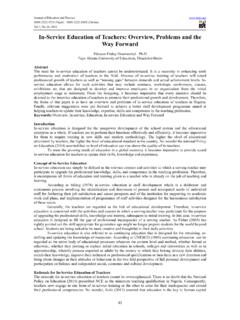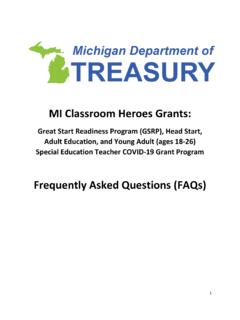Transcription of A Fact Sheet For Teachers, Counselors, And School ...
1 A FACT Sheet FOR. Teachers, Counselors, and School Professionals What is a concussion? THE FACTS: A concussion is a type of brain injury that changes the way the brain All concussions are serious. normally works. A concussion is caused by a bump, blow, or jolt to the Most concussions occur head. Concussions can also occur from a fall or blow to the body that without loss of consciousness. causes the head and brain to move rapidly back and forth. Even what Recognition and proper seems to be a mild bump to the head can be serious. response to concussions when Children and adolescents are among those at greatest risk for concussion. they first occur can help aid The potential for a concussion is greatest during activities in which recovery and prevent further collisions can occur, such as during physical education (PE) class, injury, or even death.
2 Playground time, or sports activities. However, concussions can happen any time a student's head comes into contact with a hard object, such as a floor, desk, or another student's head or body. Proper recognition and To download this fact Sheet in Spanish, response to concussion can prevent further injury and help with recovery. please visit Para obtener una copia electr nica de esta hoja informativa en espa ol, por favor visite 1 7/26/19 3:26 PM. What are the signs and symptoms of concussion? The signs and symptoms of concussion can show up right after an injury or may not appear or be noticed until hours or days after the injury. Be alert for any of the following signs or symptoms.
3 Also, watch for changes in how the student is acting or feeling, if symptoms are getting worse, or if the student just doesn't feel right.. SIGNS OBSERVED BY SYMPTOMS REPORTED BY THE STUDENT. TEACHERS AND School . PROFESSIONALS THINKING/REMEMBERING: PHYSICAL: Difficulty thinking clearly Headache or pressure in head Appears dazed or stunned Difficulty concentrating or Nausea or vomiting Is confused about events remembering Balance problems or dizziness Answers questions slowly Feeling more slowed down Fatigue or feeling tired Repeats questions than usual Blurry or double vision Can't recall events prior to Feeling sluggish, hazy, Sensitivity to light or noise the hit, bump, or fall foggy, or groggy Numbness or tingling Can't recall events after Does not feel right.
4 The hit, bump, or fall SLEEP*: Loses consciousness Feels drowsy EMOTIONAL: (even briefly) Sleeps less than usual Irritable Shows behavior or Sleeps more than usual personality changes Sad Has trouble falling asleep Forgets class schedule or More emotional than usual assignments *Ask about sleep symptoms only if the Nervous injury occurred on a prior day. What are concussion danger signs? Children and teens with a Be alert for symptoms that worsen over time. concussion should NEVER. Call 9-1-1 right away if she or he has one or more of return to sports or recreation these danger signs: activities on the same day One pupil (the black part in the middle of the eye) the injury occurred.
5 Larger than the other Students should not be allowed Drowsiness or cannot be awakened to return to their activities until a A headache that gets worse and does not go away healthcare professional experienced Weakness, numbness, or decreased coordination in evaluating for concussion says Repeated vomiting or nausea they are symptom-free and it's OK. Slurred speech to return to play. This means, until Convulsions or seizures permitted, not returning to: Difficulty recognizing people or places PE class, Increasing confusion, restlessness, or agitation Sports practices or games, or Unusual behavior Physical activity at recess. Loss of consciousness (even a brief loss of consciousness should be taken seriously).
6 For more information and tool kits for youth sports coaches and high School coaches, visit 2 7/26/19 3:26 PM. How can I recognize a concussion? WHAT TO LOOK FOR. AFTER A CONCUSSION. Teachers and School counselors may be the first to notice changes in their students. The signs and When students return to School after a symptoms can take time to appear and can become concussion, School professionals should evident during concentration and learning activities in watch for: the classroom. Increased problems paying attention Send a student to the School nurse or another or concentrating, professional designated to address health issues if you Increased problems remembering or notice or suspect that a student has: learning new information, 1.
7 Had any kind of forceful blow to the head or to the Longer time needed to complete tasks or body that resulted in rapid movement of the head assignments, -and- Difficulty organizing tasks, 2. Any change in his or her behavior, thinking, or Inappropriate or impulsive behavior physical functioning. (See the signs and symptoms of during class, concussion.) Greater irritability, and Less ability to cope with stress or What do I need to know about being more emotional than usual. my students returning to School after a concussion? Supporting a student recovering from a concussion Students who return to School after a concussion requires a collaborative approach among School may need to: professionals, healthcare providers, and parents, as Take rest breaks as needed.
8 She or he may need accommodations during recovery. Spend fewer hours at School ;. If symptoms persist, a 504 meeting may be called. Section 504 Plans are implemented when students Be given more time to take tests or complete have a disability (temporary or permanent) that assignments;. affects their performance in any manner. Services Receive help with schoolwork; and/or and accommodations for students may include Reduce time spent on the computer, reading, or writing. speech-language therapy, environmental adaptations, It is normal for students to feel frustrated, sad, and curriculum modifications, and behavioral strategies. even angry because they cannot return to recreation Students may need to limit activities while they are or sports right away, or cannot keep up with their recovering from a concussion.
9 Exercising or activities schoolwork. As the student's symptoms decrease, the that involve a lot of concentration, such as studying, extra help or support can be removed gradually. working on the computer, or playing video games, may cause concussion symptoms (such as headache or A student may feel isolated from peers and social tiredness) to reappear or get worse. networks. Talk with the student about these issues and offer support and encouragement. Revised August 2019. To learn more, go to 3 7/26/19 3:26 PM.













